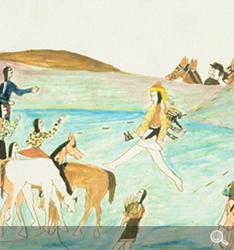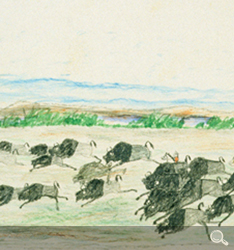

Fort Marion History Keepers
Most of the incarcerated Plains Indians who prepared ledger drawings at Fort Marion were young, in their twenties. With tuberculosis widespread among Indians, many of the Fort Marion artists, including three of the four represented in this exhibition, died within a few years of their release.
"Buffalo Chase and Encampment"Bear's Heart, or Nock-ko-ist (Cheyenne), drawn between 1875 and 1878 at Fort Marion, Florida
Bear’s Heart was known for his rich interpretations of hunting scenes, and social and religious gatherings. He attended the Hampton Normal and Agricultural Institute in Virginia, then returned home to the newly formed Cheyenne Arapaho reservation in Oklahoma, where he found employment as a carpenter. Bear’s Heart died of tuberculosis in 1882.
This drawing by Bear’s Heart’s shows an encampment, and men and women courting outside their tipis, men in black, and women in blue and green. Above them, in another level of the story drawing, are warriors on a buffalo hunt. Three riders prepare to kill the buffalo, with bows drawn and ready.
"Indian Discovery of U.S. Cavalry"Koba, or Wild Horse, or Etahdleuh (Kiowa), drawn between 1875 and 1878 at Fort Marion, Florida
r studying at the Hampton Institute, Koba continued his training in Anglo-European skills at the Carlisle Indian Industrial School in Pennsylvania, where he studied to be a tinsmith. He died of tuberculosis in 1880.
The focus of this drawing, by Koba, is a Kiowa warrior coming down from his lookout hill. He carries a pair of field glasses (either a trade item or possibly taken from an enemy combatant) which have assisted him in the discovery of the cavalry unit riding nearby. The Kiowa camp below is at rest; tribesmen welcome the scout's return and warning.
Hunting BuffaloShave Head, or O-uk-ste-uh (Cheyenne), drawn between 1875 and 1878 at Fort Marion, Florida
Shave Head was one of five students at the fort who continued religious studies in the East after being released from prison. He died of tuberculosis in 1880.
Shave Head uses a two level drawing to show a buffalo hunt with four wounded animals, and a separate hunt with the wounding of an elk. The Cheyenne warriors wear full headdress and four of the five also wear their mountain lion bow and quiver, symbolically powerful pieces of hunting gear.
Buffalo Chase Wohaw, Beef, Wolf Robe or Gu hau de (Kiowa), drawn between 1875 and 1878 at Fort Marion, Florida
Wohaw (not pictured) returned to the Kiowa reservation in Oklahoma, where he became an officer of the Indian Police and later, in the 1890s, joined the U.S. Army. Wohaw died in 1924.
Wohaw’s drawing shows a party of Kiowa warriors participating in a buffalo hunt. The warriors ride tightly together behind the herd. One buffalo has been successfully killed.
6 of 6






